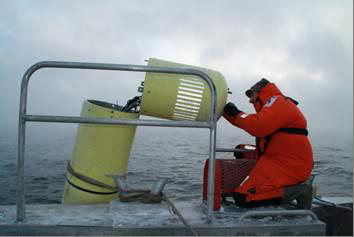
Installing a smartbuoy. © Meritaito
Objective: Evaluation of existing oil spill detection and monitoring systems, integration with decision support tools to improve situational awareness of oil spill response actions. New oil detection and monitoring sensors on different platforms, such as sensor systems on board ships of opportunity, UAVs (underwater autonomous vehicle), AUVs (unmanned aerial vehicle), gliders, smart buoys, drifters, marine radars, and other technologies, partly available already today, but not implemented for in-situ oil spill detection to make oil spill detection more accurate and cost-effective. These new sensor technologies and platforms will be tested and their capabilities to improve operational picture of oil spill response, both in open water and ice covered sea, will be performed and systems prototyped.
Planned steps:
- Evaluate the technological capabilities of oil detection sensors and systems, currently available on market, identification of gaps and user needs to be filled for better in situ situational awareness of oil spill detection, monitoring and post accident fate of oil products.
- Field tests and validation of novel oil detection sensor technologies and observation platforms, evaluation the practicality measures of these to be used in future systems.
- Operational Integration of in situ data into oil spill decision support and risk analysis tools in accident phase as well post accident monitoring the fate of oil.
- Integration and synergy of multisource data and information from in situ operational observation systems and models.
Work package leader:
Senior scientist, Dr. Tarmo Kõuts,
Marine Systems Institute
Tallinn University of Technology
tarmo.kouts@msi.ttu.ee